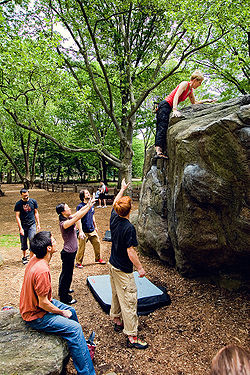
Spotting (climbing)
Encyclopedia

Climbing
Climbing is the activity of using one's hands and feet to ascend a steep object. It is done both for recreation and professionally, as part of activities such as maintenance of a structure, or military operations.Climbing activities include:* Bouldering: Ascending boulders or small...
, especially in bouldering
Bouldering
Bouldering is a style of rock climbing undertaken without a rope and normally limited to very short climbs over a crash pad so that a fall will not result in serious injury. It is typically practiced on large natural boulders or artificial boulders in gyms and outdoor urban areas...
, where the climbers are close to the ground and ropes are not typically used. The spotter stands below the climber, with arms raised or at the ready. If the climber falls, the spotter does not catch the climber, but redirects the climber's fall so that they land safely on a bouldering mat. At the very least the spotter ensures that the climber's head and back do not strike the ground directly. If the climber jumps down, the spotter can also help prevent stumbles and injuries on uneven ground. The spotter should stand with their fingers together (known as "using spoons") to avoid broken fingers.
A spotter should always be used for accident prevention. A climbing spotter will typically hold their arms up with hands in a supporting position for more or less vertical climbs. When the climber falls, the spotter's hands lightly hold the climber's hips or lower back, near the climber's center of gravity. This allows the spotter to help guide the climber's fall effectively, helping them keep their center of gravity over their feet. When on steeper, past vertical climbs, the spotter will hold their arms out in a cradling position. If the climber falls, the spotter supports the upper and middle back, helping the climber land on their feet.
A spotter may also be used to help accomplish new climbing moves. Often much of the energy in learning a new move is exerted in simply holding onto the rock. If a spotter puts even the slightest pressure on the climber's upper back or upward pressure on the hips during a move they will often give the climber the extra relief needed to learn the move. Once the move is learned, it can usually be practised and mastered without the extra help.
The term spotting originated in 1930, when a new gymnastics coach at the University of Illinois, Hartley Price, painted 4' diameter white circles on the gymnasium walls, calling them "spots". Seeing the "spots", gymnasts were supposed to think safety and look for those who could assist them through one element or another.

